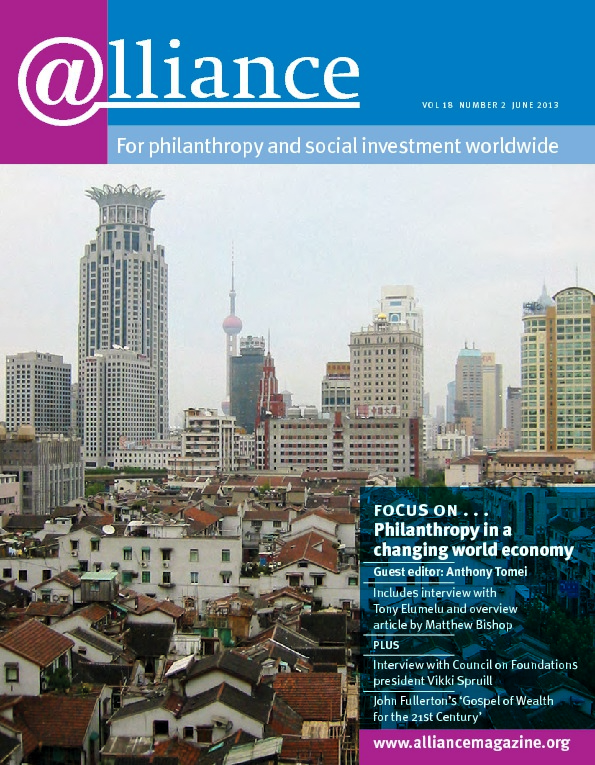What is the future of venture philanthropy in Europe? And what is the role of the European Venture Philanthropy Association (EVPA) in this future? These questions preoccupied us while we were preparing our new strategic plan. But, more basically, the question we started with was: what is venture philanthropy?
 The terms venture philanthropy, strategic philanthropy, catalytic philanthropy, social investment and impact investment mean different things to different people. EVPA of course has one of those in its name, and throughout the process we were conscious of how many different interpretations of the term there are. Are we about business or about grantmaking? Well, neither and both. But more than fighting a terminology battle, we decided that a crucial element of our strategic process should be to define clearly what we stand for.
The terms venture philanthropy, strategic philanthropy, catalytic philanthropy, social investment and impact investment mean different things to different people. EVPA of course has one of those in its name, and throughout the process we were conscious of how many different interpretations of the term there are. Are we about business or about grantmaking? Well, neither and both. But more than fighting a terminology battle, we decided that a crucial element of our strategic process should be to define clearly what we stand for.
For us, venture philanthropy is a combination of the ‘soul’ of philanthropy (private initiatives for public good) with best practice from the venture capital world (private initiatives that aim for private wealth accumulation). We want to bring these two together because we are convinced that the combination will help social purpose organizations (SPOs) to increase their impact, considerably and sustainably.
Let’s first look at this best practice. We identified seven ingredients from the venture capital world:
- High engagement Creating hands-on relationships between the supported organization’s management and the venture philanthropists.
- Organizational capacity building Building the operational capacity of the portfolio organizations by funding core operating costs rather than individual projects.
- Tailored financing Using a range of financing mechanisms, including grants, debt and equity, tailored to the needs of the supported organization.
- Non-financial support Providing services such as strategic planning to strengthen management.
- Involvement of networks Enabling investee access to networks that provide various and often complementary skills and resources.
- Multi-year support Supporting a limited number of organizations for three to five years.
- Performance measurement Stressing good business planning, measurable outcomes, achievement of milestones, and financial accountability and transparency.
What we have learned over the years is that bringing these into the collaboration with SPOs demands both a change in mindset and a change in skills: one needs to be patient and empathetic, and to recognize that it is a learning process for all involved.
The latest EVPA survey confirms that it takes time before you can offer the full package – but as the sector is maturing every year, these best practices are put into effect in more and more sophisticated ways.
A shift in return objectives
A particularly interesting development is the growing sophistication of tailored financing (with a strong increase in debt instruments and increasing interest in equity). This sophistication is complemented by a change in expected returns: more and more investors are starting to aim for some kind of financial return. This brings up an obvious question: where does one draw the line between focusing on the public good and focusing on financial returns? When is a debt instrument or an equity investment ‘societal impact first’ and when does it become ‘financial return first’? It is in this grey area that a lot of action is taking place – with the strong growth of the ‘impact investing’ industry as a key example.
Our position at EVPA was always that we want to cover the space where societal impact comes first – and that is where we want to remain. Considering the increasing importance of financial return as a tool to achieve sustainable solutions, we need to connect the two poles rather than separate them. That is why we recently decided to extend our criteria for full membership to investors that put financial return on an equal footing with societal impact. This is a further sign that EVPA wants to evolve with the sector while remaining focused on societal impact.
Another question is who is applying ‘venture philanthropy’? From its onset, EVPA believed it was crucial to engage a wide diversity of actors because that is what is required to bring together complementary skill-sets. If you look at our 160 members from 23 countries, you will see that EVPA has indeed created such a diversity. You will find old and new foundations, social investors, impact investors, social businesses – different actors with different intentions.
Why should ‘society’ care?
So, there is increased sophistication in the tools; there is increasing diversity in the intentions; there is a wide range of actors. All good – but why should ‘society’ care? Because Europe needs new models for organizing societal change. Governments will retreat, and even when they make massive investments, they have proved that they are not always the best actor to take the lead in tackling some of society’s more pressing issues. We believe that combining the best of SPOs and business investors offers potential to do better.
All the elements we have talked about are more important than they may look: venture philanthropy is not a nine-days’ wonder of the first years of the second millennium. It is taking its place among those working for a better society. This has direct consequences for EVPA – as we can and will move from promoting a concept to supporting our members, the real practitioners.
Remaining a broad church
For EVPA, the principal question behind our strategic plan was: where can we create most value, and how can we do it? We realize that, in essence, the sector is still in its pioneering phase. In order to play our part in this, we will remain a broad church that brings together the different actors, and we will continue to focus on strengthening entrepreneurial initiatives. To be constructive is a key value for us.
The most important role for EVPA is to offer a forum where the evolving intentions, results and means that make up the sector’s continuing development take place transparently so that we can all learn from each other. To do this, we will offer more and better connections between the different actors; we will develop deeper insights on the true merits of the approach; and we will increase access to high-level, field-based training through collaborations and an EVPA training offer. The end result will be that, no matter what name one decides to give to it, good solutions for societal challenges will spread faster and further.
Pieter Oostlander is the new chair of EVPA – elected in May 2013. Email Poostlander@shaerpa.org
Kurt Peleman is CEO of EVPA. Email KPeleman@evpa.eu.com
For more information
http://www.evpa.eu.com
![]()
Comment Paul Shoemaker
 I deeply respect the authenticity and earnestness of Pieter and Kurt’s perspective, and that of Doug Miller who helped make this happen, not just in Europe but in Asia (and soon in Africa and Latin America). For those of us trying to practise venture philanthropy (VP) in the trenches, EVPA fertilizes the soil in which we hope our work, and that of other VP practitioners, will grow and thrive. A few comments stand out for me.
I deeply respect the authenticity and earnestness of Pieter and Kurt’s perspective, and that of Doug Miller who helped make this happen, not just in Europe but in Asia (and soon in Africa and Latin America). For those of us trying to practise venture philanthropy (VP) in the trenches, EVPA fertilizes the soil in which we hope our work, and that of other VP practitioners, will grow and thrive. A few comments stand out for me.
- Perhaps no term has produced more interpretations in the sector these past 10-15 years. I’m not sure how much the term matters, but their list of best practices is on the money. What does matter are the practices articulated; those are the elements we think more effectively ‘help SPOs to increase their impact’. Speaking of which …
- … that philosophy and ethos of helping SPOs is a vital element. The mission and know-how rests with the SPOs, not the funders. What we can do is help them build stronger organizations, more tailored financing, etc. That ‘need to be patient, empathetic and learning’ is core to VP. We call it being a ‘trusted ally’ with our investees. Among other things, it implies we are mutually vested in the SPOs’ success or failure. We are on the line too.
- Does it matter if there are ‘different actors with different interpretations’ within EVPA? Largely no, as long as the members genuinely believe in some/many of those best practices. Remember, what EVPA is doing is growing the ecosystem, so they should bring in a greater diversity of players at many points along the VP spectrum; EVPA should be a ‘big tent’.
One last perspective, from someone who has been slogging around in this area for 15 years: when a handful of us (Robin Hood, New Profit, Venture Philanthropy Partners et al) started this work, there was considerable derision from traditional philanthropies. ‘If pigs could fly’ was a common refrain. The dynamic they didn’t get – which is implied in Pieter and Kurt’s piece, but can be amplified – is this: the most vital, truly change-making principle of VP is the emotional, visceral, roll-up-our-sleeves, mutual commitment between a funder and SPOs. At Social Venture Partners, now established in 31 cities across four countries, we see VP as all about taking the risk of working side by side, explicitly dealing with the power dynamics, and living or dying with the success of the SPOs in our communities. If you follow all of those best practices, that mutual commitment is inevitable. Go EVPA!
Paul Shoemaker is executive connector, Social Venture Partners. Email
shoe@svpseattle.org



Comments (0)